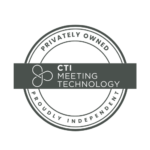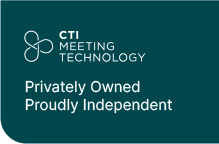Many events fail to reach their potential audience. Not because the content isn’t valuable, but because the website isn’t working for you. Event planners and PCOs in STEMM have a unique challenge: the event’s website is a brochure, program book, help desk, and storefront – all in one. All of that for scientists and clinicians with little to no time and very high standards.
Your event website is the digital front door to your event. It’s where potential attendees form their first impression, learn about your event, and decide whether they want to be part of it. The good news? With clear, engaging content and a seamless event-management stack behind it, your site can become the most efficient member of your team.
Building a great event website isn’t just about branding and functionality, but about crafting an efficient and professional experience for your attendees. Sounds exhausting? No worries! We’ve got you covered with 20+ tips to design a powerful website that converts, including a checklist:
Why This Matters for STEMM Events
- You’re building trust from the first click. A busy researcher doesn’t have time to sift through Google results; your homepage should say, “You’re in the right place.”
- Clear paths lead to better outcomes. Your site must integrate with the registration, abstract management, and scheduling tools so the event content updates automatically, not manually.
- Your audience expects precision. They want exact dates, speaker credentials, downloadable agendas, registration deadlines. All presented cleanly and accessibly.
- Inclusivity is release-ready. Your site must serve multiple needs, including mobile users, accessibility requirements, visitors from various time zones, and international researchers with visa logistics.
20+ Tips for Building a High-Impact Event Website
A successful event website is built on a foundation of strategic design and user-focused content. Here are the key tips you need to know, covering everything from the big picture to the smallest details.
Lay a Strong Foundation & Boost SEO
1. Lean, memorable domain: Don’t burden with years or locations; always put the year in the page title instead.
2. Brand deliberately: Select accessible color palettes and fonts that convey credibility.
3. Prioritize Text over images: Place event titles and dates in text so search engines and screen readers capture them.
4. Optimized headers and metadata: Use titles like “International Conference 2026 – Registration & Submissions”.
5. Organize with clean structure: Use URLs like /register, /speakers, /agenda for clarity.
These foundational steps ensure your site is discoverable and trustworthy, even before a visitor reads a word.
Design That Says “We Know Your Time Matters”
6. Mobile-first mindset: Your participants might access your site from a train or lab; reduce taps, use large buttons, and test on common devices.
7. Simple, sticky menu: About, Agenda, Speakers, Registration; that’s usually all your user needs. Keep CTAs visible.
8. Hero message that lands fast: Who, what, when, where, and one clear CTA.
9. Ease dense information with accordions and cards: Visa information, poster specs, fees… Keep the info structured and handy.
10. Keep it light and fast: Compress visuals and code so everyone, everywhere, loads pages in a blink.
Content That Converts
11. Above-the-fold essentials: Say what it is, why it matters, and what to do next.
12. Evidence-based event pitch: “Join 500 peers,” “Earn 20 CME credits,” or “Submit by June 15.”
13. Speaker profiles with purpose: Include headshots, affiliations, topics. Always with links to lab pages or Google Scholar if possible.
14. Social proof: Show past sponsors, institutional logos, or brief attendee testimonials.
15. Event agenda: Allow downloads and filterable views (by track, date, topic).
16. Highlight key dates: Early-bird, deadlines, travel cutoff—make them direct and visible.
17. Compact FAQ: Visa letters, refunds, ethics guidelines, accessibility—cover it proactively.
18. Venue & Travel: Maps, travel tips, accommodations, accessibility routes, and time-zone clarity.
Registration & Abstract Submission Made Easy
19. Transparent pricing options: Member vs. non-member, student rates, etc. Explain what’s included clearly.
20. Context + form side by side: Set expectations about form length and purpose.
21. Streamlined entry: “Institutional email” or wallet pay keeps conversions high.
22. Clear submission guidelines: Word limits, categories, rules, disclosures, and a template download for authors.
23. Automated reminders: Set up automated emails for confirmations, abstracts accepted, visa letters, and more, to cut down on support emails.
Accessibility, Inclusion & Respect Built In
24. WCAG 2.2-AA compliance: Alt text, captions, good contrast, simple keyboard navigation.
25. Multilingual where needed: Offer key pages in other languages when inviting global researchers.
26. Accessibility & wellbeing: Note lactation rooms, quiet zones, hearing loops, assistive tech, and how to request help.
Let Your Event Technology Do the Heavy Lifting
A top event website isn’t just a brochure, it’s a dynamic hub:
- When sessions or speakers change, your website, app, and emails update instantly.
- Abstracts flow into the agenda; registration updates availability.
- Personal schedules sync across platforms. No manual edits, no broken links.
When your registration, abstract management, scheduling, and communications are truly integrated, you build trust and save yourself hours!
Mistakes That Quietly Kill Conversions (and How to Fix Them)
- Too many choices on the homepage.
- Fix: One primary CTA per screen. Tuck secondary actions into the header or footer.
- Hard-to-find deadlines.
- Fix: Persistent “Important Dates” component and a calendar file (.ics) for each key date.
- Dense, unstructured long-form copy.
- Fix: Break into bullets, pull-quotes, accordions, and visual highlights; add a 2-sentence executive summary at the top of key pages.
- No measurement.
- Fix: Track sessions (views), events (CTA clicks), and funnels (registration completion). A/B test button copy and hero headlines to see what drives sign-ups.
Your Event Website Content Checklist (Copy-Paste Into Your PM tool)
Homepage
- [ ] H1 with event name + year; H2 with audience and outcome.
- [ ] Dates, location, and format (in-person, hybrid, virtual).
- [ ] 1–2 proof points (e.g., “3,000+ attendees, 750 posters”).
- [ ] One primary CTA (“Register Now”); one secondary CTA (“Submit Abstract”).
- [ ] Important deadlines strip + .ics add-to-calendar links.
Program
- [ ] Filterable agenda (track, topic, level, CME).
- [ ] Keynotes and plenaries highlighted.
- [ ] Session pages with learning objectives and speakers (link to profiles/scholar pages).
Speakers
- [ ] Headshot, bio, affiliation, lab link, social handle.
- [ ] Session cross-links and “See similar sessions.”
Registration
- [ ] Pricing table with inclusions; discount rules explained.
- [ ] Payment options available.
Abstracts
- [ ] Categories, formatting rules, conflict/disclosure policies; template download.
- [ ] Submission portal; status notifications; important deadlines.
Sponsors/Exhibitors
- [ ] Prospectus download; tiered benefits; audience demographics.
- [ ] Lead retrieval/app features and traffic drivers explained.
Venue/Travel
- [ ] Map; transport options, parking, accessibility routes; visa letters.
- [ ] Hotel block links, cut-off dates, and policies.
Accessibility & Policies
- [ ] Code of conduct; inclusivity statement; accessibility accommodations.
- [ ] Photo/recording, data privacy, refund/transfer policies.
Tools & Platforms: Build Faster Without Reinventing the Wheel
When choosing your event tech stack, look for:
- All-in-one event software like cOASIS, with integrated registration, abstract & presentation management, scheduling, mobile app, and communication tools. This keeps all your event content in one place for an easier overview, and it syncs automatically in every meeting platform.
- Flexible CMS or page builder (e.g., WordPress, Squarespace, Wix) that offers multiple customization options to adapt to your organization’s corporate identity and needs.
- SEO helpers (XML sitemaps, schema plugins) to make your event site appear in the right searches.
- Analytics & testing (GA4, A/B testing) to validate changes.
Our tip:
Start simple—a clear and concise page including important event information, registration links, and deadlines. Build your website as you build your agenda.
Wrapping Up…
Remember, a high-impact STEMM website includes:
- Clear, credible storytelling for potential attendees.
- Conversion-first UX that simplifies registration and submission.
- Integrated event tech that keeps your content accurate everywhere.
- SEO-driven distribution amplified by speakers and societies.
Use the checklist above to set up your event website or conduct an audit of your existing one to identify areas where clarity, functionality, or integration may be falling short. Even small adjustments, like surfacing deadlines, simplifying navigation, or syncing your program with your event software, can make a measurable difference in registrations, submissions, and overall attendee satisfaction.
Remember: your website is more than a marketing tool. For many participants, it’s their first impression of your meeting and their primary source of truth from planning to onsite. A site that feels clear, welcoming, and seamlessly integrated with your event technology shows respect for your community’s time and professionalism.
Want an event tech platform that does the heavy lifting for you? Let’s chat! Book a quick call with our team, and we’ll tailor the right solution for your needs.





